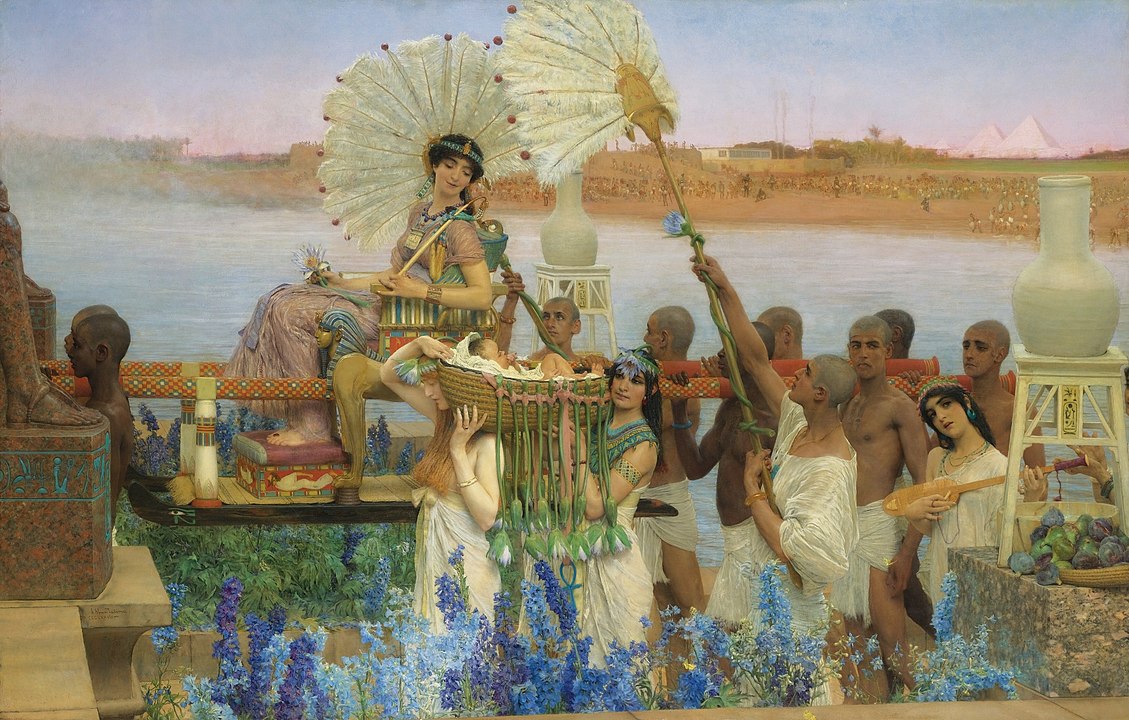
Meaning of The Finding of Moses by Lawrence Alma-Tadema
A Masterpiece of Victorian Historicism and Symbolic Opulence
Lawrence Alma-Tadema, one of the most celebrated painters of the Victorian era, is widely known for his romanticized and opulently detailed depictions of ancient civilizations. Among his many works, The Finding of Moses (1904) stands out as a prime example of his craftsmanship and his fascination with antiquity. This painting encapsulates the blend of realism, historical imagination, and symbolic depth that defines Alma-Tadema’s oeuvre. In this essay, we explore the meaning, symbolism, and historical context of The Finding of Moses, how it was painted, the figures it portrays, its artistic style, and its present-day location. Through this, we uncover the layers of narrative and aesthetics that make it a cornerstone of Victorian art and a cultural interpretation of a biblical tale.
Who Was Lawrence Alma-Tadema?
Sir Lawrence Alma-Tadema (1836–1912) was a Dutch-born British painter renowned for his portrayals of classical antiquity. Born in the Netherlands, he moved to England in the 1870s and became a naturalized British citizen. Alma-Tadema became a member of the Royal Academy and was eventually knighted for his contributions to the arts. His signature style was marked by meticulous attention to historical detail, dazzling marble textures, and serene yet evocative human figures. He drew heavily from archaeological sources to ensure accuracy in his depictions of Greco-Roman and Egyptian life, often blending sensuality with the grandeur of ancient architecture.
What Is The Finding of Moses All About?
The painting captures the biblical story of the infant Moses being discovered in a basket along the Nile River by Pharaoh’s daughter. According to the Book of Exodus (2:1–10), Moses was born to Hebrew parents during a time when Pharaoh had decreed that all male Hebrew infants should be killed. His mother, in an act of desperation and faith, placed him in a basket and set him afloat on the river. He was found by Pharaoh’s daughter, who took pity on him and decided to raise him as her own in the Egyptian royal court.
In Alma-Tadema’s interpretation, this moment becomes a visually extravagant and emotionally nuanced tableau. The scene is infused with the luxurious atmosphere of the Egyptian elite, reimagined through a Victorian lens.
Visual Composition and Artistic Techniques
The Finding of Moses is a large oil-on-canvas painting, notable for its theatrical composition and astonishing attention to detail. Painted in 1904, it represents the culmination of Alma-Tadema’s career and artistic vision.
The central figure in the composition is Pharaoh’s daughter, shown in regal attire, surrounded by an entourage of female attendants. The baby Moses is being presented to her, emerging from the basket adorned with fine linens. The Nile River glimmers in the background, bordered by lush reeds and stone steps. The figures are dressed in ornate robes, with gold jewelry, and the setting is framed by classical Egyptian columns and motifs, reminiscent of archaeological finds of the time.
Alma-Tadema employed a hyperrealistic technique with an almost photographic clarity. He was a master of textures,his rendering of marble, silk, water, and human skin are second to none. He also had a unique ability to evoke mood and narrative through static scenes, creating what art historian Edmund Gosse once called “an illusion of a moment paused in eternity.”
Symbolism and Meaning
Though on the surface, The Finding of Moses appears to be a faithful retelling of a biblical scene, it is imbued with layers of symbolic and cultural meaning:
Divine Providence: The moment of Moses being found symbolizes the intervention of divine will in human affairs. Despite the edict against Hebrew infants, Moses is spared, indicating his special destiny.
Motherhood and Mercy: Pharaoh’s daughter embodies compassion that transcends social and racial boundaries. Her gesture of accepting a foreign child into the royal household is a powerful symbol of empathy and maternal love.
Colonial Subtext: Painted during the height of the British Empire, the scene also subtly reflects contemporary Victorian interests in empire, colonialism, and the “civilizing” mission. The romanticization of ancient Egypt mirrors British views of themselves as inheritors and curators of ancient wisdom.
Artifice and Reality: The highly stylized environment suggests that Alma-Tadema was not merely recreating history, but staging a spectacle,a theater of antiquity. The painting is not just about what happened but how the Victorian era imagined it happened.
What Is Happening in the Scene?
In the painting, the moment being captured is just after the baby Moses has been retrieved from the basket by one of the servants and is now being presented to the princess. The princess, adorned in flowing garments and seated like a queen, is caught in the act of beholding the child for the first time. Around her are courtly women, some looking at the child with curiosity, others seemingly engaged in conversation or contemplation.
The child himself, wrapped in rich cloths,possibly meant to echo the narrative that he was already “marked” for greatness,is not crying, but calm, adding to the sense of predestination. The river and the distant cityscape form a calm and majestic backdrop, emphasizing the grandeur and stability of the Egyptian world Moses is about to enter.
The attention to costume, setting, and facial expressions brings a theatrical flair to the biblical story, aligning it more with operatic storytelling than straightforward religious art.
Artistic Style and Classification
Alma-Tadema’s The Finding of Moses belongs to the tradition of Victorian historicism and academic classicism. His work also embodies elements of Orientalism, a popular genre in 19th-century European art that depicted Middle Eastern and North African subjects in a romantic and often exoticized manner.
Key characteristics of this style include:
Realism with Idealization: While every object and surface is rendered with meticulous accuracy, the overall effect is idealized, creating a dream-like reconstruction of antiquity.
Use of Light: Alma-Tadema’s manipulation of light,often Mediterranean and soft,heightens the sensuality and serenity of the scene.
Architectural Precision: He often used studies from archaeological sites and museums to recreate historically plausible environments, blending scholarly interest with artistic fantasy.
In essence, the painting is a blend of narrative art, biblical storytelling, and historical romanticism, all filtered through the sensibilities of a Victorian audience enamored with the classical past.
Creation of the Painting
The painting was completed in 1904, toward the end of Alma-Tadema’s life. It is among his last major works and reflects decades of refinement in his technique and vision. The work was commissioned by Sir John Aird, a wealthy British engineer who had significant business interests in Egypt, including work on the Aswan Dam. Aird’s fascination with Egypt and imperial ambition may have influenced both the commission and the emphasis on Egyptian grandeur in the piece.
Alma-Tadema was known to conduct rigorous research before beginning a painting. He collected photographs, fabrics, artifacts, and ancient texts to ensure accuracy. His studio was famously filled with props, archaeological reproductions, and even imported marbles. For this painting, he likely drew from multiple museum visits and his personal archive to recreate the scene with plausible historicity.
Critical Reception
Upon its completion, The Finding of Moses was met with critical acclaim, although by the early 20th century, Alma-Tadema’s classical style was beginning to fall out of fashion. The rise of modernism led to a temporary eclipse of his reputation, but recent decades have seen a significant reassessment of his work. Today, scholars and collectors recognize Alma-Tadema as a master of his genre and appreciate his paintings not just for their technical virtuosity but for their cultural richness.
The painting exemplifies how art can serve as a dialogue between past and present,between biblical lore and Victorian ideals. It is a testament to the enduring power of narrative art to shape our understanding of history, myth, and identity.
Where Is the The Finding of Moses Painting Located Today?
As of today, The Finding of Moses is housed in the Perez Simón Collection, one of the largest private art collections in Latin America. The collection belongs to Juan Antonio Pérez Simón, a Mexican businessman and art collector who has acquired numerous European masterpieces.
The painting has been part of several international exhibitions, including the 2010–2011 traveling show “Victorian Visions” and “Alma-Tadema: At Home in Antiquity” (2016–2017), which toured major institutions such as the Fries Museum (Netherlands), Leighton House Museum (London), and the Belvedere Museum (Vienna).
Because it is privately owned, the painting is not on permanent public display, but it continues to be loaned for exhibitions and academic study, ensuring its visibility and influence in the art world.
The Finding of Moses by Lawrence Alma-Tadema is not merely a depiction of a biblical episode but a richly layered canvas that reflects Victorian ideals, imperial subtexts, artistic innovation, and symbolic storytelling. It is a painting that invites viewers to dwell in the beauty of its surfaces while contemplating the deeper meanings behind its composed serenity.
Through its dazzling details, historical imagination, and emotional restraint, the painting exemplifies Alma-Tadema’s genius and continues to fascinate audiences over a century after its creation. Whether as a work of faith, a study in ancient elegance, or a mirror of its own time, The Finding of Moses remains one of the most compelling artistic interpretations of a moment that changed the course of biblical history.




